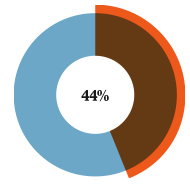Cities of Innovation: Milan
Key indicators
ICT Infrastructure

Average broadband speed (Mbps)

Broadband coverage 100 Mbps download speed
— €90 million invested by Vodafone to have 5G coverage in 100% of the metropolitan area by 2019 plus implementation of 41 5G enabled innovative projects — WiFi Italia offers 760 access points with unlimited data and connection time
Local, national and international transport links

Malpensa airport passengers (26th busiest airport in the world)

International Train times
— 3 airports, Malpensa, Linate and Orio al Serio with more than 200 destinations connected by train and bus to the city centre — 3 main railway stations with 10 international daily destinations *upon completion of the Lyon-Turin tunnel
University links and access to talent

QS World University ranking (Politecnico di Milano)

Tertiary-educated workforce
— 18 university-level institutions, among the most reputed in the world, including Politecnico di Milano — 44% tertiary-educated people in the workforce — 88% of the workforce involved in tertiary activities
Costs and availability of workspace

Prime office rent

Co-working spaces
— More than 60 co-working spaces, among them 11 makerspaces/ fablabs
City support for start-ups and SMEs

Member city

Events
Member of SCALE (Startup City Alliance Europe), which brings together the main European cities to facilitate the exchange of information and contacts to do business in the EU
Financial support and access to investors & accelerators

Start-up grants 2012-2016

Incubators & accelerators
— 3 spaces for spin-offs in the vocational training centres of via Giusti, via Visconti and via Pepe — Incubator of creative enterprises, Milan LUISS Hub for Makers and Students, FabriQ incubator of social economy and innovation, Consorzio Vialedeimille and Alimenta at the PTP Science Park
Additional information
ICT Infrastructure
- — 99% of families enjoy broadband coverage of >30Mbit
- — 368public hotspots per million inhabitants (EY, 2017)
- — 50,000 WIFI connections per day, 24 minutes on average
The digital infrastructure of the Municipality of Milan includes an interoperability platform, portals and open-data. The municipality has 852 servers, 201 applications (including the portal system, the geo-portal, CRM, interoperability platform, API catalogue, and business intelligence), 185 DB.
SMEs can also utilise the E015 Digital Ecosystem, an initiative promoted by the Lombardy Region together with different private actors. The E015 Digital Ecosystem encourages the creation of digital relationships between different subjects, both public and private, interested in enhancing their digital heritage by sharing or enriching the software solutions for their users with the functionality and information shared by the other participants.
Local, national and international transport links
Malpensa Airport serves a wide network of European and international destinations. Linate offers convenient connections to European and Italian cities and Orio al Serio is an operating base for all major European low-cost airlines.
The new metro line M4, expected to be completed by 2021, will be one of the fastest airport-city-center connections in Europe, connecting Linate airport directly to the city center in less than 15 minutes.
There are three main railway stations: Milano Centrale, Milano Garibaldi and Milano Cadorna:
— 2h25 away from Rome
— 2h25 away from Venice
— 1h40 away from Florence
— Daily international destinations include Basel, Bern, Dijon, Lausanne, Marseille, Munich, Nice, Stuttgart, Vienna and Zurich.
Milan is well served by Lombardy’s transport network, one of most widespread and efficient in Europe, with train, bus, metro and trolleybus networks.
Milan has four metro lines (plus one under construction), covering a total of 96.8km with 113 stations, and 122 bus and tram routes covering over 1,000km. Compared with major European capitals, Milan has competitive public transport rates, with a single journey costing €1.50 and yearly subscriptions starting from €200.
Milan is also a leader in promoting new green public transportation. In 2012 a road pricing scheme (Area C) was launched in order to improve the living conditions of visitors and those who live, work and study in the city. In 2016 the rules governing Area C were further tightened, preventing access to the city centre by all commercial vehicles from 8am to 10am. Car-sharing is widely used – with over 2,900 free-floating cars, as is the public bike-sharing service with 280 stations, 4,650 bikes and 1,000 electric bikes.
Free-flowing services are offered by Mobike and Ofo, whilst station- based services are provided by BikeMi.
Car sharing offer consists of station based services (E-Vai and Ubeeqo) and free floating services, provided by Car2go, DriveNow, Enjoy and Share’Ngo. A free- floating scooter sharing service (MiMoto) is also available in Milan. With the new Sustainable Urban Mobility Plan adopted in June 2017, the environmentally friendly policies already introduced in 2013 are further enhanced, aligning Milan’s public transportation system with the increasingly greener and citizen- friendly spirit of the city.
The plan earmarks substantial investments to extend the underground, tram and bus lines in order to better connect Milano to its metropolitan area and provinces and increases the use of shared electric vehicles (e.g. 10,000 new bikes have been made available in the suburbs). The plan also boosts policies such as the integrated fare system and free travel for people with disabilities.
University links and access to talent
There are 18 university-level institutions, among the most reputed in the world, including Politecnico di Milano. Its public universities include Milano State University, the Milano Polytechnic and Bicocca University; its private universities include the Bocconi University, the Catholic University, the Humanitas University, the San Raffaele University, and the Brera Academy, which has prestigious classes in Art Sciences.
Nearly 100 degree courses are taught in English. In addition, the New Academy of Fine Arts (NABA), the Istituto Marangoni and the European Design Institute (IED) offer 18 different degrees in fashion, design, product design, interior design and advertising.
Costs and availability of workspace
The Milanese offer of grade A office spaces has greatly increased over the last decade, thanks to the recent revamping of the Porta Nuova area, one of the main business districts of Milan and now one of Italy’s most high- tech and international districts. Porta Nuova contains the country’s tallest skyscraper and other buildings (e.g. Unipol and Gioia 22) are under construction. Another major intervention is set to affect the former Expo site, that will be transformed in a future science, knowledge and innovation park.
Since 2013 the Municipality of Milan has been a pioneer in Italy in supporting innovative forms of employment and the sharing economy by co-financing operators who chose to invest in the city and especially in the peripheral areas. Milan recognises, facilitates and incentives the creation of spaces for coworking and makerspaces/fablabs.
Financial support and access to investors & accelerators
The municipality of Milan has also been supporting new entrepreneurial ideas by promoting innovative finance by fostering the provision of microcredit in partnership with other subjects, and creating a reward based civic crowdfunding platform.
There are seven incubators/ accelerators including PoliHub and Speed MI Up. The city network has 10 structures supported by the municipality for the kick-off and development of new companies and start-ups.

